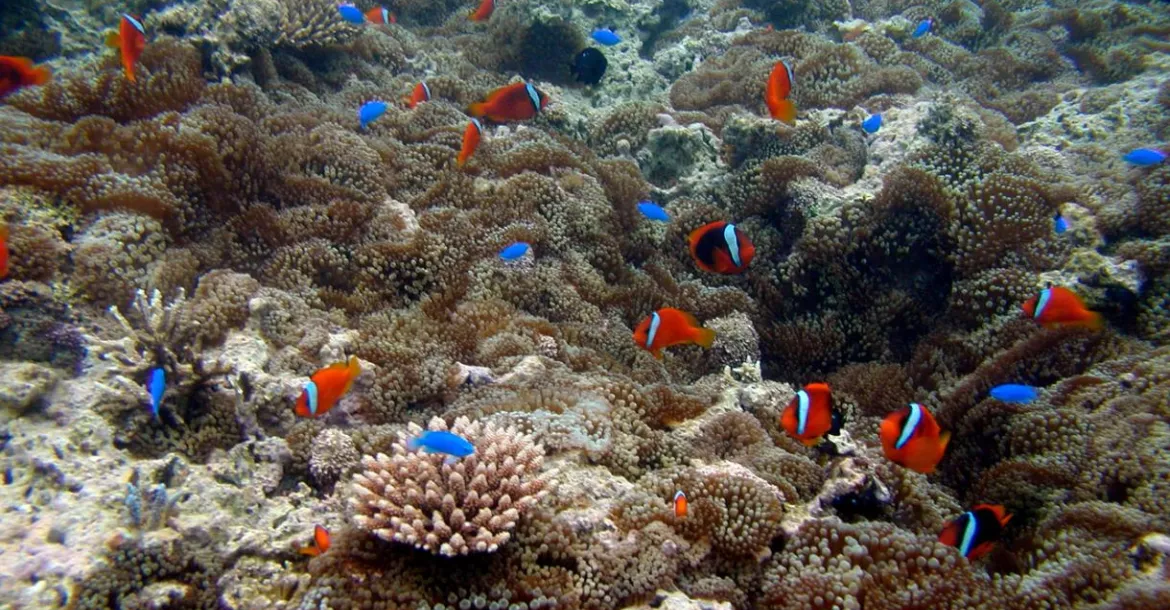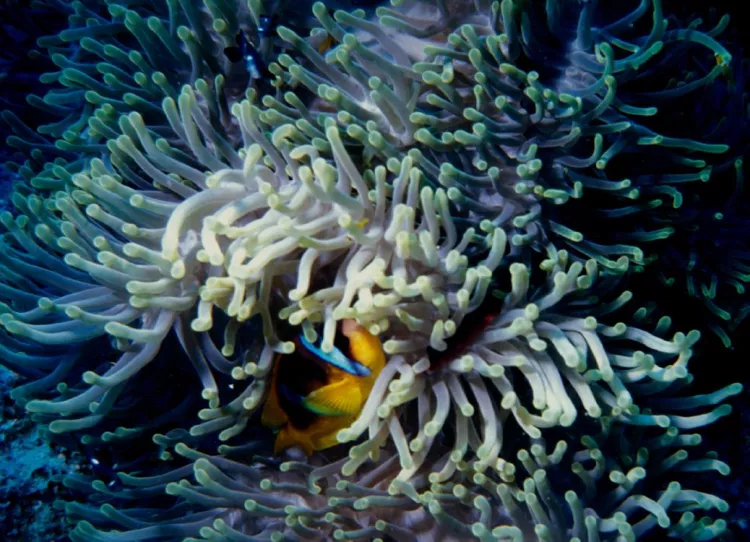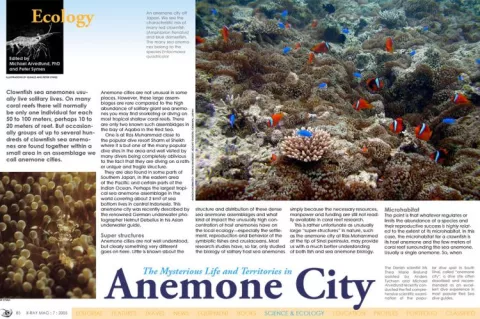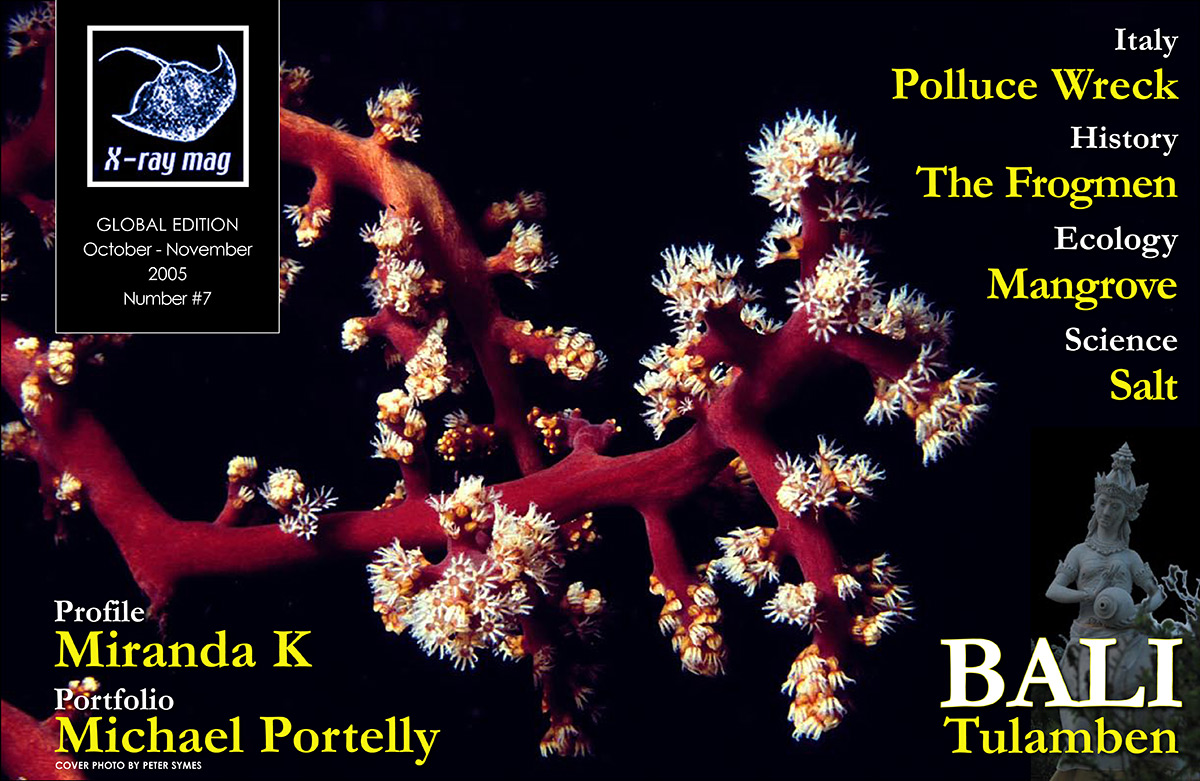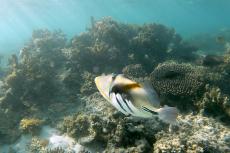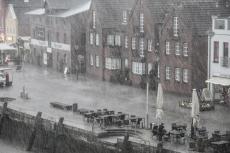Clownfish sea anemones usually live solitary lives. On many coral reefs there will normally be only one individual for each 50 to 100 meters, perhaps 10 to 20 meters of reef. But occasionally groups of up to several hundreds of clownfish sea anemones are found together within a small area in an assemblage we call anemone cities.
Contributed by
One is at Ras Muhammad close to the popular dive resort Sharm el-Sheikh where it is but one of the many popular dive sites in the area and well visited by many divers being completely oblivious to the fact that they are diving on a rather unique and fragile structure.
They are also found in some parts of Southern Japan, in the eastern area of the Pacific and certain parts of the Indian Ocean. Perhaps the largest tropical sea anemone assemblage in the world covering about 2 km2 of sea bottom lives in central Indonesia. This anemone city was recently described by the renowned German underwater photographer Helmut Debelius in his Asian underwater guide.
Super structures
Anemone cities are not well understood, but clearly, something very different goes on here. Little is known about the structure and distribution of these dense sea anemone assemblages and what kind of impact the unusually high concentration of host anemones have on the local ecology—especially the settlement, reproduction and behaviour of the symbiotic fishes and crustaceans. Most research studies have, so far, only studied the biology of solitary host sea anemones simply because the necessary resources, manpower and funding are still not readily available in coral reef research.
This is rather unfortunate as unusually large “super-structures” in nature, such as the anemone city at Ras Mohammed at the tip of Sinai peninsula, may provide us with a much better understanding of both fish and sea anemone biology.
Microhabitat
The point is that whatever regulates or limits the abundance of a species and their reproductive success is highly related to the extent of its microhabitat. In this case, the microhabitat for a clownfish is its host anemone and the few meters of coral reef surrounding the sea anemone. Usually a single anemone.
So, when nature comes up with an unusual super-structure such as an anemone city, all the usual dynamics and relationships between the organisms in the microhabitat are bound to change drastically. New and more complex interactions arise between the surroundings, the fish, the crustaceans and the anemone hosts, and we see marked changes in physiological and behavioural patterns. These characteristics can be quite obvious to the observant visiting diver.
Exactly which patterns, how, when and why this complexity and infrastructure is put together is something we know practically nothing about. This gives cause for great concern as these rare structures are at great risk of disappearing in front of our very eyes due to heavy loads of ignorant visiting scuba divers.
At risk
The popular Aqaba anemone city assemblage of the magnificent sea anemones (Heteractis magnifica) is, for example, found at the southernmost point of the Sinai Peninsula, northern Red Sea. It is situated on a reef approximately 150 meters east of the popular Shark and Yolanda Reef. At present, about 20-30 large dive boats with up to 300 divers and 1500 snorkelers visit this magnificent superstructure every day. Most of these visitors have absolutely no education in proper behaviour on coral reefs.
And the carrying capacity of daily visitors to anyone anemone city may only be only 1/10 of the present load. Consequently, the risk of this anemone city disappearing forever within the next decade or two is very real. Despite these facts, the first scientific study ever of Sinai’s “anemone city” did not take place until the summer of 2002 when a Danish research team visited the site. This article is a summary of that study.*
Anemone city at Ras Muhammad consists of massive amounts of the clownfish sea anemones and consequently also the local two-banded anemonefish (Amphiprion bicinctus) and the three-spot damselfish (Dascyllus trimaculatus). The former are obligate symbionts in host sea anemones and the latter are facultative symbionts as juvenile in host sea anemones. (See explanation in the sidebar.)
Location
More precisely, anemone city is situated on an underwater plateau of approximately 100 x 75 meters stretching down to an approximate 20-meter depth. It begins at a depth of about 2 meters beneath a short vertical coral wall from there it drops down to 7-9 meters at an angle of 30-45º.
From this depth to approximately 20 meters, the plateau is relatively horizontal, sloping only 5-15º. At approximately 20 meters, it ends in a rather sharply defined drop-off which plunges to a depth of about 800 meters. This is clearly not the place to drop your camera. A total of 190 large clownfish sea anemones were counted here. Some were solitary, and some were clusters of presumably clonal morphs (offspring produced from “buds”).
Record
The anemones were distributed from a depth of 3 meters down to about 40 meters, which is a new record for the species magnificent sea anemone.
Why here?
Perhaps this is because of the very clear water almost devoid of terrestrial and freshwater input. Simultaneously, the location of this anemone assemblage renders it subject to unusual and sometimes strong currents. The major currents pass in the surface waters up the Gulf of Suez and the Gulf of Aqaba (the latter primarily via the Strait of Tiran) resulting in upwelling of nutrition-rich waters especially from the deep waters of the Gulf of Aqaba.
Currents matter
These nutrition-rich currents pass right by the anemone assemblage at Ras Mohammed. At 22-24 meters of depth, approximately at the edge of the plateau where it dropped to vertical the reef was devoid of anemones. Perhaps their absence was caused by the stronger currents here.
In the same manner, there were few anemones above 9 meters depth, where there were heavy wave-induced surges. However, the solitary anemone exposed to the surges at 3 meters depth seemed to cope well with it; it was one of the largest anemones of the entire assembly.
Are the fish the cause or result?
Factors contributing to the existence of these superstructures of sea anemones may be the relatively large schools of the three spot damselfish.
Recently, Israeli experiments have shown that the giant sea anemone E. quadricolor are benefiting from their mutualistic symbiosis with the fishes, to such a degree that the growth rate is significantly hampered if the anemonefish are removed from the host anemone.
This result may lead to the speculation that the large shoals of three spot damselfish increase the assemblage in mutualistic positive feedback between anemone and fish. This could perhaps be based on increased amounts of ammonium, nitrate and phosphate, which are likely to be found here. This is merely speculation, however.
Feedback
What are the ecological feedback mechanisms between these fish and anemones? Do more fish lead to more anemones, which in turn, lead to more fish? If the above thoughts seem to be true, how are they related to the question of clonality in H. magnifica and its distribution pattern?
Do the abundance of anemones and anemonefish result in unusual odour plumes to the surrounding waters? Since anemonefish depend on olfactory cues to finding their host anemones at settlement, might one expect altered settlement patterns of anemonefish on reefs with anemone assemblages?
What do we know?
The distribution and abundance of the species magnificent sea anemone, which is the “anemone city” species in the Gulf of Aqaba, was quite different from most other giant sea anemone species in Aqaba. Magnificient sea anemones (H. magnifica) are found in only two relatively large assemblages in the southern part, Anemone City, and a few solitary individuals at Raz Ghazlani a few kilometres north of Ras Mohamed.
Usually, magnificent sea anemones are only found above 20 meters of depth. H. magnifica is distributed from the eastern Pacific to the western Indian Ocean and the Red Sea.
However, it reproduces asexually only in the rim areas of its distribution i.e. the Red Sea and the eastern Pacific Ocean. Incidentally, this distribution seems also to apply to magnificent sea anemones assemblages. Thus, the origin of the large aggregations of magnificent sea anemones is probably the asexual reproduction rather than settling of young sexually reproduced anemone polyps.
Lots of fish to see
At this particular anemone city, the researchers counted nearly 2000 individual three-spot damselfish hovering above the sea anemones. That is a lot of fish.
The largest specimens of three spot damselfish were never seen among the anemone tentacles, but adult three-spot damselfish will sometimes stay in groups in the vicinity of the host anemone, however, they do not associate with them, and are not protected from the anemone nematocysts.
“Gangs and territories”
The total number of recorded two-banded anemonefish was 243, of which 91 were dominant. A fish territory could consist of any combination of solitary and clustering host sea anemones. Usually, it consisted of a cluster and some nearby solitary sea anemones.
Usually, territories of dominant and sub-dominant two-banded anemonefish covered the same area. The territories of two-banded anemonefish and three spot damselfish were often overlapping as the group of three spot damselfish would swim from one two-banded anemonefish territory to another.
The three-spot damselfish territories had less defined borders than those of two-banded anemonefish. In areas with many host anemones close to one another, the groups of three spot damsel-fish could become very large with one large shared territory.
Hovering groups
Apart from the smallest specimens, the three spot damselfish all behaved almost alike in hovering in larger or smaller groups ½-2 meters above the anemones, forming some very large groups below 10 meters. When disturbed the three spot damselfish groups would perform a synchronized rapid descent towards the host anemones.
The anemonefish
The two-banded anemonefish usually swam closer to the host anemones than the three-spot damselfish.
Usually, the large sub-dominant two-banded anemonefish were farthest away; they usually covered the whole territory with the biggest fish swimming the furthest. Small sub-dominant two-banded anemonefish were rarely observed more than ½ meters from the host anemones.
In Anemone City, these adults intermingled with the groups of juvenile three-spot damselfish. The territory borders seemed well-defined though no aggressive displays were observed between territories. The fish just did not cross certain borders.
The territorial behaviour of anemonefish seem to be highly plastic; the intra- and interspecific territorial behaviour may depend more on the local distribution pattern, number and size of the host anemones, than perhaps on the anemonefish species.
The significance
The unusual large structure and many inhabitants of Sinai’s Anemone City may be the source for new generations of clownfish and sea anemones in most of the Gulf of Aqaba due to its size and placement in string currents from the southern Red Sea leading into the straits of Tiran.
Therefore, further protection of Anemone City is most likely an urgent matter. Unfortunately, the environment of the Ras Mohammed National Park is under increasing stress from pollution largely generated by the local tourist industry. Although impressive, the anemones of the assemblage were fewer and the surrounding corals more stressed than just a few years back. ■
Published in
-
X-Ray Mag #7
- Read more about X-Ray Mag #7
- Log in to post comments

